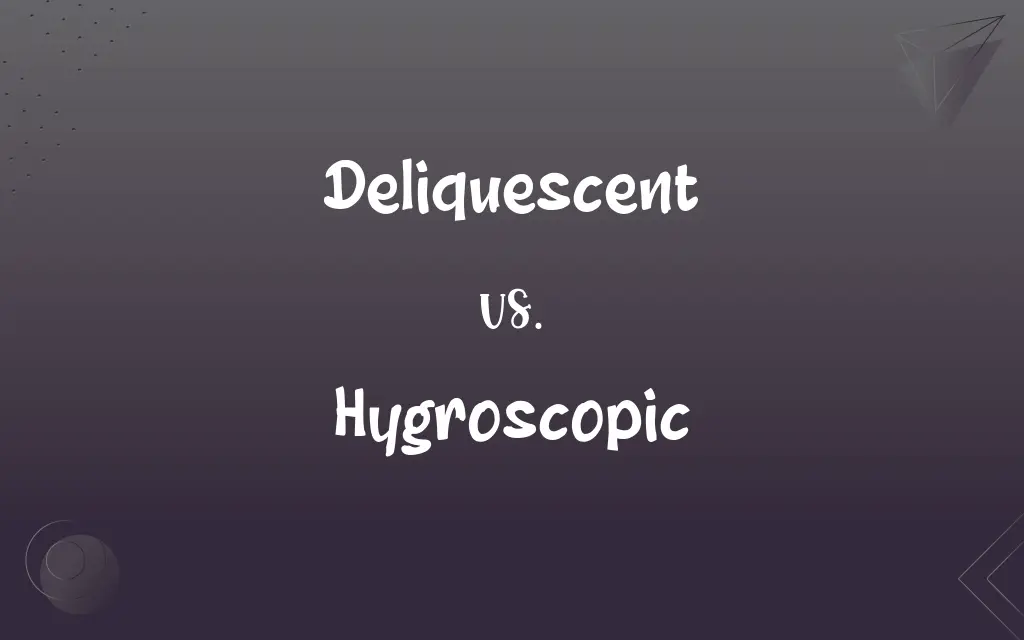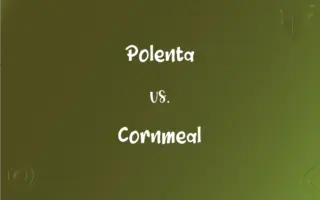Deliquescent vs. Hygroscopic: What's the Difference?
Edited by Janet White || By Harlon Moss || Updated on October 27, 2023
Deliquescent substances absorb moisture from the air and dissolve in it, while hygroscopic substances absorb moisture without dissolving.

Key Differences
Deliquescent and hygroscopic are both terms used to describe the ability of materials to attract and hold water molecules from their surrounding environment. While they both deal with moisture absorption, they do so in slightly different ways. Deliquescent substances are known to absorb so much water that they eventually dissolve and form a liquid solution. On the other hand, hygroscopic substances can absorb water but don't necessarily dissolve in the absorbed water.
Both deliquescent and hygroscopic substances play crucial roles in various industries, especially in the chemical and food industries. Deliquescent materials, due to their ability to turn into a liquid upon absorbing moisture, are often used as desiccants in certain applications. In contrast, hygroscopic materials, because of their capability to retain moisture without dissolving, find applications in products that require moisture retention.
It's important to handle both deliquescent and hygroscopic substances with care in a laboratory or industrial setting. Deliquescent substances can become problematic if they absorb moisture and turn into a liquid, especially if a solid state is needed for a particular application. Hygroscopic materials, while not turning liquid, can change their physical properties with the intake of moisture, which can affect their usability.
One might encounter both deliquescent and hygroscopic substances in everyday life. Common salt, for instance, is deliquescent; if left exposed to humid air, it can clump together due to moisture absorption and dissolution. Silica gel, a common packet found in many product packages to keep contents dry, is hygroscopic as it absorbs moisture but remains solid.
Comparison Chart
Definition
Absorbs moisture and dissolves in it.
Absorbs moisture but doesn't dissolve.
ADVERTISEMENT
Common Use
As desiccants in certain scenarios.
In products that require moisture retention.
Behavior in Humid Conditions
Turns to liquid.
Remains solid, but might change properties.
Example
Common salt.
Silica gel.
Industries
Common in chemical and food industries.
Used across various industries including food.
Deliquescent and Hygroscopic Definitions
Deliquescent
Characteristic of substances that liquefy by attracting water from the air.
The deliquescent crystals quickly turned into a liquid on the humid day.
ADVERTISEMENT
Hygroscopic
A term describing materials that attract and retain water from the surrounding environment.
Silica gel packets are hygroscopic and help keep packaged goods dry.
Deliquescent
A term denoting the transformation of solid to liquid due to moisture absorption.
The deliquescent behavior of the chemical was evident in the tropical climate.
Hygroscopic
Characteristic of materials that can hold water molecules without transitioning to a liquid state.
The hygroscopic properties of certain fibers make them perfect for moisture-wicking clothing.
Deliquescent
Pertaining to a material's ability to dissolve upon moisture absorption.
The deliquescent nature of the compound made it challenging to store.
Hygroscopic
Referring to substances that can intake water vapor from the atmosphere.
Due to its hygroscopic nature, the wood expanded in the rainy season.
Deliquescent
Related to the dissolution of a substance when exposed to atmospheric moisture.
It's advised to store deliquescent materials in airtight containers to maintain their solid form.
Hygroscopic
Pertaining to the ability of a substance to absorb moisture without dissolving.
The hygroscopic powder remained solid even in the damp room.
Deliquescent
A substance that absorbs moisture and becomes liquid.
The salt became deliquescent and formed a puddle in the humid room.
Hygroscopic
Denoting the quality of a substance to retain water without changing its phase.
The hygroscopic abilities of the desiccant kept the electronics free from moisture.
Deliquescent
To melt away.
Hygroscopic
Readily absorbing moisture, as from the atmosphere.
FAQs
Give me an everyday example of a hygroscopic substance.
Silica gel, often found in small packets inside product packaging, is hygroscopic.
Can deliquescent materials be harmful?
They can be if they absorb moisture and turn into an unwanted liquid form, especially if a specific solid state is essential.
What does deliquescent mean?
Deliquescent refers to a substance's ability to absorb moisture from the air and dissolve in it.
How are hygroscopic substances used in industries?
They're used in products that require moisture retention and in desiccants to absorb moisture.
How do industries tackle the hygroscopic nature of raw materials?
By storing them in controlled environments, using desiccants, and choosing packaging that limits moisture exposure.
Can the deliquescent nature of a substance be beneficial?
Yes, in certain applications where moisture absorption and dissolution are desired outcomes.
What's the opposite of deliquescent?
Efflorescent substances lose water to the atmosphere, transitioning from a hydrated to an anhydrous form.
Why are deliquescent materials challenging to store?
Because they can turn to liquid upon absorbing moisture, potentially affecting their intended use.
Why is it essential to understand the hygroscopic properties of materials in construction?
Because hygroscopic materials can change their properties with moisture intake, potentially affecting the stability or purpose of a structure.
Are all salts deliquescent?
No, not all salts are deliquescent; it depends on their ability to absorb and dissolve in moisture.
Are there any tools to measure hygroscopicity?
Yes, instruments like gravimetric hygrometers measure a material's hygroscopic tendencies.
How do deliquescent substances impact food preservation?
They can attract moisture, leading to clumping or dissolution, which might affect the food's shelf life and texture.
Do hygroscopic materials have a saturation point for moisture absorption?
Yes, there's a limit to how much moisture a hygroscopic substance can absorb, depending on its properties and the surrounding conditions.
How does hygroscopic differ from deliquescent?
Hygroscopic substances absorb moisture without dissolving, while deliquescent ones dissolve upon moisture absorption.
What's an example of a deliquescent substance?
Common salt can act as deliquescent in very humid conditions, absorbing moisture and dissolving.
Can a substance be both deliquescent and hygroscopic?
No, the terms are mutually exclusive. Deliquescent substances dissolve in the moisture they absorb, whereas hygroscopic ones don't.
Do hygroscopic materials always remain solid?
Typically, yes. Hygroscopic materials absorb moisture but remain solid, though their properties might change.
Can a deliquescent substance revert to its solid form after turning liquid?
It can if the liquid solution is allowed to evaporate and the conditions don't favor further deliquescence.
How can one prevent substances from showing their deliquescent nature?
By storing them in airtight containers away from moisture.
Is humidity a factor in how hygroscopic a substance behaves?
Yes, higher humidity levels can lead to increased moisture absorption in hygroscopic materials.
About Author
Written by
Harlon MossHarlon is a seasoned quality moderator and accomplished content writer for Difference Wiki. An alumnus of the prestigious University of California, he earned his degree in Computer Science. Leveraging his academic background, Harlon brings a meticulous and informed perspective to his work, ensuring content accuracy and excellence.
Edited by
Janet WhiteJanet White has been an esteemed writer and blogger for Difference Wiki. Holding a Master's degree in Science and Medical Journalism from the prestigious Boston University, she has consistently demonstrated her expertise and passion for her field. When she's not immersed in her work, Janet relishes her time exercising, delving into a good book, and cherishing moments with friends and family.































































